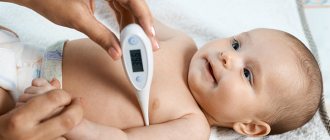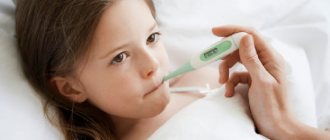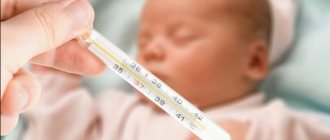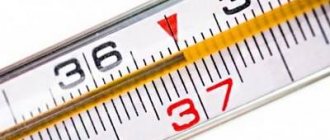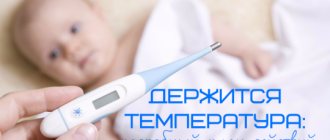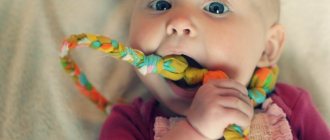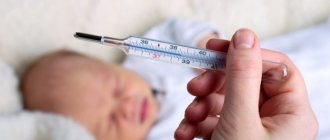The most common cause of high temperature in a child is ARVI. In the typical course of the disease, fever should decrease on the 4th day and return to normal on the 7th. If it lasts a long time, then the reasons need to be looked for not in ordinary rhino- and adenoviruses. To find this reason, you need to take a closer look at the accompanying symptoms. And in some cases, undergo a serious diagnostic examination. Only when you understand why your child has a fever for a long time will it become clear what to do.
Normal values for different methods of measuring temperature
There are three main ways to measure a child’s body temperature:
- Oral. When using this method, a normal value is considered to be 37.0° C. A higher value can be considered a sign of an infectious or bacterial disease.
- Rectal. With this method, the normal value is 37.5°C. This technique is most often used for children in the first year of life, when it is quite difficult to measure the temperature in any other way due to the activity of the baby.
- Axillary. The longest time-consuming method for determining temperature. The norm is indicators within 36.5-37.0°C.
Oral method
Rectal method
Axillary method
How to measure temperature correctly?
For the results to be reliable, you must adhere to certain rules:
- measurements are taken at approximately the same time;
- a separate thermometer must be allocated for the child;
- using the oral measurement method, the tip of the thermometer is fixed under the tongue and the mouth is closed loosely for three minutes;
- When taking measurements rectally, the edge of the thermometer is lubricated with oil and inserted into the anus for one minute;
- When measuring the temperature in the armpit, the tip of the thermometer must be held at the desired point for at least 10 minutes.
It is important to consider factors that influence the result of body temperature measurement:
- The baby is in an excited state, crying and running. As a rule, in this situation, the measurement indicators may be somewhat overestimated, therefore, before placing the thermometer, the baby must be reassured.
- The child is dressed very warmly.
- The child is sweating. Before starting the measurement, the baby’s body must be wiped with a towel, as wet skin can cause biased indicators.
- Excessive eating before measurements also increases the readings by one or two degrees.
Causes of high temperature
Understanding the nature of high fever in a child, it is easier to determine treatment and speed up the process of full recovery.
Diseases
Sudden fever without signs of infection (snot, cough) may indicate developing acute pharyngitis or sore throat. As a rule, a few days after the first temperature jump, purulent rashes and redness can be seen on the mucous membranes of the oral cavity. With a sore throat, a white coating is visible on the tonsils.
Fever can also be triggered by stomatitis, a common childhood disease in which numerous ulcers or watery blisters can be seen in the mouth. The baby suffers from pain and high fever, he is constantly capricious and refuses to eat.
Fever may also indicate the development of acute otitis media. The main symptom of the disease is severe pain in the ears. A child who cannot yet speak signals otitis media with gestures (constantly holding on to the sore ear and crying a lot).
In the first two years, children are diagnosed with roseola, a disease that occurs against the background of fever. The red rashes characteristic of this pathology spread throughout the body.
Teething
During the period of teething (from 5 months to one year), fever in a child is a common occurrence. At the same time as this symptom, the child becomes restless, cries and eats poorly. As soon as the tooth erupts, the high fever and other accompanying symptoms disappear.
Overheat
Often a child develops a high fever without any symptoms of viral or bacterial diseases.
The main heat transfer processes will be fully formed only in 5-6 years. Until this age, children easily overheat, even in winter, provided they wear layers of clothing. In addition to fever, an overheated child behaves very restlessly, is capricious, and refuses to eat. The skin turns red and sweat is released.
The most dangerous condition is when overheating causes drowsiness and lethargy in the baby. Against the background of a high temperature, the child may develop dehydration, hallucinations, and loss of consciousness.
At the first signs of overheating, the child must be undressed as soon as possible and given clean water to drink.
Vaccinations
One of the post-vaccination reactions is increased body temperature. Pediatricians warn about such a manifestation in advance. The norm is body temperature up to 38.5°C. This is how the body reacts to the introduction of external elements - antigens of foreign viruses.
When the immune system neutralizes the antigens of the virus, antibodies and pyrogenic substances begin to be actively produced in the blood, which are associated with an increase in body temperature.
What vaccines cause fever?
Depending on the vaccine's ability to provoke specific responses in the body, the risk of developing a high fever varies.
The following vaccinations can cause fever:
- BCG vaccine. Injections sometimes cause a slight increase in temperature.
- Vaccination against hepatitis B. After administration of the drug, fever occurs, but very rarely.
- Polio vaccine. The vaccine has the least reactogenicity, but body temperature may increase slightly.
- DTP injections. Administration of the drug often provokes fever.
- Vaccine against rubella, measles, mumps. Negative reactions are rare, but a slight increase in temperature is possible.
- Flu vaccine. The injections occasionally cause fever and chills.
- Pneumococcal vaccine. After vaccination, only one child in 20 develops a high fever.
- Mantoux test. Possible reactions to the vaccine include fever, weakness and headache.
A slight increase in body temperature after vaccination is a normal reaction, provided that it lasts 3-4 days. Otherwise, the situation requires consultation with a doctor.
The child has a temperature of 38 for the fourth day
High temperature in a child
A high temperature in a child often takes parents by surprise.
When the baby becomes weak and hot, climbs onto his mother’s lap and cuddles up to his chest, all first aid techniques disappear from his mind. Mom begins to rush around the apartment confusedly, calling knowledgeable people and frantically rummaging through medical reference books about children's health. Therefore, it is better to always have on hand a reminder on how to provide first aid to a child with a high fever.
- If the temperature does not exceed 38 C, and the child tolerates it normally, then there is no need to give antipyretics. The fact is that at elevated temperatures the body fights infection more effectively, therefore, unless absolutely necessary, it should not be brought down. The exception is those cases when the child suffers from a neurological disease (registered with a neurologist) or simply has a hard time tolerating the temperature - then antipyretics should be given starting from 37.5 C.
- If the temperature rises above 38 C, the child should be given an antipyretic drug recommended by a doctor (Children's Panadol, Efferalgan, Nurofen). For very young children, it is better to use the medicine in suppositories; for older children, you can give the medicine in syrup form. Do not use aspirin under any circumstances! Aspirin during a viral infection (in children under 12 years of age) can cause a dangerous complication - Reye's syndrome.
- Be sure to call a doctor to determine the cause of the fever. Note the symptoms that accompany an increase in temperature - runny nose. cough. vomit. diarrhea. pain in the head, stomach, rash, etc.
- If a child starts having convulsions or the temperature exceeds 40 C, immediately call an ambulance, and before it arrives, give the child an antipyretic.
- Try putting your baby to bed. Read him an interesting book, watch cartoons, play calm games. Although it is best for the baby to sleep, rest, and gain strength.
- It is recommended to feed a sick baby with easily digestible food. Temporarily exclude meat (especially fried), fatty, sweet and canned foods from your diet.
- Give your child plenty of water - then toxins formed during the life of viruses are washed out of the body. The best thing is warm tea with lemon, raspberries, warm milk with honey (if you are not allergic to it). Fruit drinks, compotes, juices containing vitamin C are very useful. Mineral water, herbal decoctions, and fruit teas are also suitable.
- Ventilate the room regularly and, if possible, humidify the air. For this purpose, you can place a 3-liter jar of water in the room and hang a wet towel. The air temperature should not exceed 20-21 degrees.
- There is no need to put a hundred clothes on your child and wrap him up excessively. These measures can lead to heat stroke. if the temperature rises to dangerous levels. Dress the sick child lightly, cover him with a diaper or a light blanket so that excess heat can escape unhindered.
- Do not wipe your child with vinegar, alcohol or cover him with cold heating pads. Alcohol is absorbed very well through the skin and can cause poisoning to a child’s body.
- If the elevated temperature persists for more than 3-4 days after the start of treatment, it is necessary to call the doctor again to adjust the treatment.
- First, undress your baby. Take off his warm clothes, and replace the sweater or tights with a cotton T-shirt and shorts. Synthetics are completely useless, as they interfere with normal thermoregulation.
- Measure your temperature every 25-30 minutes. Place a notepad and pen or piece of paper nearby and record all measurements. Then it will be easier for you to explain to the doctor the dynamics of the baby’s condition.
- There is no need to create a draft in the room. It's better to just place the baby on his back with an asterisk. In this position, when air access to all main vessels is open, the temperature will decrease due to purely mechanical cooling.
- If you are not a supporter of medications, then try wiping your child with water and vinegar. You can make a 1:1 solution. However, if the child is too small, or if you know that he has sensitive skin, then you can dilute one tablespoon of vinegar in a glass of water at room temperature. You should not take water from the refrigerator, this will be extra stress for the child. Wipe your forehead, armpits, limbs, under the knees and back.
- You can give tea with raspberries or brew linden flowers bought at the pharmacy.
- If the thermometer stubbornly creeps up, then you can give antipyretics - Nurofen syrup (for children) or put a Tsefekon candle. The main thing is to pay attention to the dosage. It must be appropriate for the child's age.
The child has had a fever for 5 days. What to do?
And now the season of colds and other equally unpleasant diseases has begun again. Although, to be absolutely honest, this period practically does not end in families in which either there is more than one child, or the child attends a preschool institution. An experienced mother can hardly be frightened by the child’s temperature if the numbers on the thermometer do not exceed 39&hellip. Almost everyone is familiar with the set of necessary measures that help bring down the temperature, if not to normal, then to 37.5 C. However, there are situations in life when even seasoned parents lose their peace of mind and begin to panic. For example, if a child’s temperature rises and remains above normal for 5 days. Moreover, there are two options for the development of events.
The child has a temperature of up to 37.5 C for 5 days
Most likely, this indicates some kind of chronic inflammatory process. In this case, you should ask in great detail, without nerves, how the baby is feeling. Maybe something is bothering him or he has a cough or runny nose... Perhaps your stomach or ear hurts. It should be remembered that a child under three or four years of age perceives all pain in the abdomen as concentrated in the navel area, perhaps slightly above or below. This is what often misleads many parents who, after palpating the area where the appendix is located and not receiving a positive response from the child, calm down and decide that everything is fine. If the appendix is inflamed, the temperature will not rise above 37.3 C. In any case, if the child’s temperature lasts for 5 days (not even higher than 37.5), you should not self-medicate. It is necessary to consult a doctor and have your blood and urine tested. After all, if the baby has some kind of inflammatory process, then it should be diagnosed and treated!
The child has a temperature of 38.5 for 5 days
Let’s immediately determine that fever is good! The presence of a high temperature indicates the body’s active fight against pathogenic viruses. Doctors do not recommend lowering the temperature before the value on the thermometer rises to 38.5 C. Fever, as a rule, accompanies infectious diseases of a viral nature (pneumonia, acute respiratory viral infections, acute respiratory infections, etc.), traumatic brain injuries, infections of bacterial etiology, for example pneumonia, otitis or tonsillitis. If we do not consider the infectious and traumatic nature of the fever, then only allergic reactions remain.
A set of measures if a child has a fever for 5 days
We will consider a set of measures to reduce the temperature to at least 38.5 C!
Pediatrician help is needed!
And remember, if a child has a fever for 5 days, this is a reason to call a pediatrician. You should not self-medicate with either a temperature of 37.5 or 38.9 C! If your baby has a temperature above normal for 5 days, be sure to show him to a specialist. Don't joke about your child's health!
Temperature in a child under one year old
In babies, during the first few days of life, the normal temperature is considered to be from 37 to 37.4 degrees. Then it gradually decreases and a reading of 37 degrees should not cause panic among parents. Normalization of a child’s body temperature to the usual 36.6 degrees occurs during the first year of life. A mother needs to know what temperature is normal for her baby. To do this, she needs to measure her temperature in the morning, lunch and evening for several days. This should be done at the same time, when the child is calm and healthy, and record the temperature after each measurement. Keeping a temperature diary will help the mother determine if the child has an increase in temperature caused by pathogens. The temperature of infants is measured in the armpit, inguinal fold or rectum. If you have a pacifier thermometer, then the temperature can be measured orally, i.e. in the mouth. You should know that the temperature in the rectum (rectal) is one degree higher than in the armpit and half a degree higher than the temperature in the mouth.
The temperature of a child under one year old may rise slightly (by several hundredths of a degree) if the baby was extremely active or overheated. You should not resort to antipyretics if the child’s temperature rises to 38.5 degrees. This is a normal protective reaction of the body, indicating that it is fighting pathogens. Children, unlike adults, tolerate elevated temperatures more easily, but some infants react to elevated temperatures with convulsions. The risk group includes babies under two months and children with respiratory and circulatory diseases. Often, seizures in infants signal the development of a neurological disease, so you should consult a neurologist about such a baby’s reaction.
Typically, antipyretics are used at a temperature of 38.5-39 degrees. Preference should be given to drugs containing paracetamol and ibuprofen. They can be in the form of syrups or candles. If an increase in temperature in a child is accompanied by vomiting, then it is better to use suppositories; they begin to act 30-40 minutes after administration. The effect of syrups appears faster, within 20-30 minutes. Children under one year old should not be given aspirin or analgin to reduce their temperature. In addition to allergic reactions, these antipyretics can cause serious disturbances in the functioning of internal organs. For example, analgin negatively affects the kidneys and liver and inhibits hematopoiesis.
To relieve fever, the child needs to create conditions conducive to normal heat exchange. To do this, you need to remove his diaper and warm clothes (especially wool socks). The temperature of a child up to one year is reduced with wraps of water (five parts) and apple cider vinegar (one part). The water temperature should be close to normal body temperature. Use a gauze cloth to wipe the baby's hands, calves, ankles and forehead. If your child has lost his appetite, you should not force feed him. The body's forces are mobilized to fight the disease, so it is difficult for it to digest food. It is better to give your child more to drink. Give him warm tea with lemon, raspberries, fruit juice, compote, water with honey, or give him juices diluted with water.
Our electronic assistants
Tell me if I need to bring down the temperature, the doctor came and said not to bring it down to 38.5, but my soul is not in the right place! He’s lying there asleep, his nose can barely breathe from the sniffles, and besides, he’s all hot from this temperature!
If he is sleeping, then do not knock him down, the doctor is right, they knock him down to 38.5 only if the child is very worried about this temperature. If he falls asleep, then he is not so bothered; many children tolerate the pace normally. 39
38-38.5 - viral infection, temp. They don’t knock it down to 38.5, because During this period, the body most productively fights viruses on its own, and if you give medicine for no reason, it causes a sharp rise in temperature, which is even worse for the body
I knock it down if I see it’s really bad. But nothing will happen from 38. Listen to your doctor - temperature is a sign that the body is fighting, activating its forces to fight the virus. And you want to send the main forces to the rear. The higher the rate, the more interferon is produced. So judge for yourself, it’s a pity that it’s burning, or it’s a pity that you can’t cope with a simple cold without antibiotics, because a complication has developed, because your mother has slowed down the pace.
Omsk forum. Read and add topics.
If steps 1 and 2 are ineffective, give an antipyretic. The first line drug in children is paracetamol. it doesn’t matter in what form - suspension, syrup, suppositories, etc. Give your child an age-appropriate dose of the medicine (indicated in the instructions for the medicine). Paracetamol can be given no more than once every 6 hours (thus, no more than 4 times a day). The second-line drug is ibuprofen (Nurofen, Ibufen). If the temperature rises less than 6 hours after giving paracetamol or its ineffectiveness, give the child an age-appropriate dose of ibuprofen. Ibuprofen can be given no more than once every 8 hours (no more than 3 times a day). Alternating between paracetamol and ibuprofen is effective, as the temperature often rises again before paracetamol can be given again.
If antipyretic therapy is ineffective, call a pediatric emergency room.
Under no circumstances should children be given analgin, aspirin or nimesulide!
Temperature in a child (3 months): is it necessary to bring it down?
When a child appears in any family, especially if it is the first-born, mothers begin to protect him from the very first days. However, very often they worry too much about the baby, thinking that the slightest deviation in temperature from 36.6 is the first sign of a terrible, insidious disease! Complete chaos begins to arise in their head, many questions arise (What could be the cause of such a temperature? How to help the baby at this critical moment? Is it necessary to immediately call an ambulance or run to see a pediatrician?)
How to bring down the temperature?
Rub the baby's chest, back, tummy, arms, legs with regular, not very cold water without any vinegar, vegetable oil, vodka, and so on.
If these measures do not allow you to reduce your temperature to normal levels, you should call an ambulance team, which will take you to the on-duty children's hospital, where you can consult with a pediatrician.
Thus, a temperature in a 3-month-old child is not such a terrible phenomenon and you will be able to cope with it yourself, while maintaining your strength and nerves.
Temperature 38 in a child
The child began to feel unwell, his cheeks began to glow, and the alarmed mother reached for the thermometer - and it was 38! What to do? How to help your baby? Is it necessary to bring down the temperature of 38 and why did it rise in the first place? We’ll try to give answers in this article.
Let's start with the fact that there is no need to panic, because an elevated temperature in itself is a sign that the body is actively fighting the infection that has entered it. That is, the presence of elevated temperature is a rather good sign. How effective the fight against infection will be depends on the amount of interferon produced in the body, and this amount, in turn, directly depends on the increase in temperature - the higher the temperature, the more interferon is produced.
Therefore, you should not immediately reach for antipyretic drugs - this will not help your body. Whether it is necessary to bring down the temperature to 38 depends only on how your baby reacts to it. If the child calmly goes about his business, does not cry, is not depressed, there is no need to knock him down. If you see that an elevated temperature is difficult for a child, do not torment him, knock him down. The best remedy for lowering fever in children is paracetamol. It is produced in a variety of dosage forms - tablets, capsules, syrups, and suppositories. The choice of form depends on the age of the child.
How to help a child with a temperature of 38?
- When the temperature just rises, it is necessary to ensure that the body can get rid of excess heat.
- Give plenty of fluids - ideally offer your child a drink every half hour. It is best to give various fruit and herbal teas - with linden blossom, rose hips, fruit drinks with cranberries and lingonberries. The best remedy for sweating was and remains raspberry tea. For babies under one year old, there is no better drink than raisin decoction. The temperature of the tea should be equal to body temperature +/- 5 degrees.
- Ventilate the room more often (15 minutes every hour), but at the same time make sure that there are no drafts. The air in the room should be fresh and cool.
- There is no need to force feed a child if he does not want to. If the child does not refuse food, then it is better to give him small portions, but more often.
- Under no circumstances should you lower your temperature using various types of vinegar or alcohol rubdowns. By applying alcohol or vinegar to your child’s skin, you will only worsen his condition, because these, frankly speaking, harmful substances will enter the blood through the skin.
Temperature 38 in an infant
It is necessary to remember that an infant's thermoregulation centers are still poorly developed and he overheats very easily. If the reason for the rise in temperature is simple overheating, then as soon as you change the baby’s clothes and rock him to sleep, his body temperature will quickly drop. If the temperature stays at 38, then you need to see a doctor, and before he arrives, try to provide the baby with a gentle regime - protect him from unnecessary irritants, give him plenty to drink, make sure he doesn’t overheat.
Vomiting and diarrhea at a temperature of 38
If vomiting and diarrhea stubbornly do not stop, signs of dehydration appear - dry skin, sunken eyes, dark urine and a sharp decrease in the number of urinations, a sunken fontanelle in an infant - it is necessary to urgently call an ambulance.
Sources: medportal.ru, www.syl.ru, iamtiptop.ru, womanadvice.ru
Next articles:
When to provide first aid and what kind of aid?
Basic recommendations and rules that must be followed if a child has a fever:
- Give him bed rest. As a last resort, try to stop active games, transferring them to a quiet, peaceful direction.
- Give the baby a drink. Pure water will keep the body from dehydration and speed up the process of removing toxins from the body.
- When the reading exceeds 38.5°C, it is necessary to use an antipyretic drug. For babies under one year old, medications are mainly used in the form of syrup or suppositories (Ibuprofen, Viferon). For older children, medications in tablet form (Nurofen, Panadol) are allowed for use.
- In cases where a high temperature is accompanied by vasospasm (white fever), along with an antipyretic, the child is prescribed an antispasmodic, for example, Papaverine (from 6 months). Massage of the arms and feet will help speed up the process of absorption of the medicine.
You can learn about the rules for reducing fever without medication from the video created by the “Doctor Komarovsky” channel.
Emergency medical care is required in the following cases:
- if the mark on the thermometer exceeds show 38.9°C;
- if the child is less than three months old;
- when convulsions appeared at the head of the fever;
- if the baby has previously been diagnosed with diseases of the pulmonary, cardiac or nervous system.
When to lower the temperature
The child may not always feel hot; with “white fever,” the child has a fever and his hands and feet are cold, and he may feel chills. Therefore, it is not always possible to determine whether a child has a fever or not just by placing a hand to the forehead. Be sure to measure the temperature with a thermometer.
Temperature 39 and above
Fever above 39 is dangerous for the child with the possibility of developing serious complications. up to cerebral edema.
Temperature 38 - 38.5
If the child’s condition worsens at a temperature of 38-38.5, headaches, muscle pain, sleep disturbances, etc. appear. Please note: it is enough to lower the temperature by 1-1.5 degrees; there is no need to lower the temperature to normal levels by taking antipyretic drugs.
Important! If the temperature does not exceed 38.5°C and the child’s condition does not worsen, there is no need to reduce it (except for children under 3 months of age). Fever is not a disease, but a response of the body’s immune system to the invasion of the virus.
Temperature 38 and below
Children under 3 months of age inclusive, as well as children with a history of seizures, severe lung and heart disease, can be prescribed antipyretic drugs at temperatures below 38 degrees.
Important: Seek emergency medical help immediately if a child 3 months or younger has a temperature above 37.5 degrees Celsius .
There are two reasons for this urgency:
- The protective layer of cells between the bloodstream and the central nervous system is very thin in children 3 months of age and younger. This means that if there is a bacterial infection, the bacteria can "cross" this boundary and very quickly have a negative effect on the central nervous system.
- Symptoms of a severe infection at such a young age may not appear the same as they do in older children. That is why it is important to undergo diagnostics as quickly as possible to identify the cause of the increase in temperature. It is impossible to hesitate and take a wait-and-see attitude in this case; we are talking about the life of a child.
What not to do
If a child has a fever, it is prohibited to:
- Reduce the temperature when the reading is below 38.5°C (especially in the first days of the disease). The exception is heat stroke, as well as the presence of chronic diseases in the baby. Ignoring this recommendation can cause harm to the body. By slowing down the body's protective functions with the constant use of antipyretics, parents, without realizing it, give impetus to the development of infection. Ultimately, this can cause severe complications.
- Use warming compresses, cups, mustard plasters. Doctors warn that the desire of caring parents to speed up the healing process in this way can lead to the opposite effect.
- Wrap up the child. At high temperatures, sweating increases. Thus, the body gets rid of excess heat. If the child is dressed too warmly, the process of thermoregulation is disrupted, which only aggravates the course of the disease.
- Wipe the baby's body with an alcohol or vinegar solution. Vapors from vinegar or alcohol are poisonous to a child’s body. Penetrating into the lungs, they cause poisoning of the body, dizziness and nausea.
- Give your child sweet carbonated drinks. At high temperatures, it is important to maintain normal water balance. But you only need to drink clean water, herbal teas or unsweetened fruit drinks. Drinking excessively sweet drinks at high temperatures risks the fact that the body, losing moisture, is saturated with sugars - an ideal breeding ground for the proliferation of pathogenic microorganisms.
Why does the child have a fever if he feels normal?
Many parents have experienced this situation. The famous pediatrician Komarovsky explains in his books and broadcasts how to proceed. He focuses on three points:
- when the baby has a fever and nothing else, you need to call a doctor and carry out an adequate diagnosis;
- the child must be constantly given warm, but not hot, drinks;
- You need to create comfortable conditions in the room - temperature 18-20℃ and humidity from 50 to 70%.
This condition, without signs of a cold or other obvious pathological symptoms, may have several causes.
Thermoneurosis
Long-term fever with a child feeling relatively normal is characteristic of this disease, in which low-grade fever is a reaction to any stressful condition.
The pathology is associated with changes in the thermoregulation center, which is located deep in the brain, in the hypothalamus. Some doctors consider thermoneurosis a type of vegetative-vascular dystonia.
With this disease, the temperature does not rise as much as with a cold - it is usually higher during the day, and decreases in the evening. In children over 12 years of age, an aspirin test is used to clarify the diagnosis.
In the treatment of thermoneurosis, the following groups of drugs are used:
- soothing herbal tinctures: valerian, hawthorn, motherwort;
- medications to improve cerebral circulation: glycine, cerebrolysin, piracetam;
- vitamins C. group B, PP, folic acid and other tonic agents.
Growing fever, or constitutional
Associated with periods of rapid development of the body. The child’s temperature does not rise above 38℃. Happens more often in teenagers. A more significant increase is observed during physical and mental stress. The hands are cold.
This condition is treated with restorative and sedative medications.
Other reasons
- Neurogenic fever . With it, the high temperature does not go down for a long time and persists even after the use of antipyretics. Associated with brain diseases: hydrocephalus, migraine, epilepsy, meningitis, tumors and cysts, encephalitis, trauma.
- Side effects of some medications . In some cases, the following drugs increase a child’s temperature: salicylic acid (aspirin) and other salicylates;
- interleukins;
- Amphotericin B;
- interferons.
Video
In a video published by the “Everything will be fine” channel, famous pediatrician Evgeny Komarovsky talks about the peculiarities of a child’s fever and accompanying symptoms, such as cough, runny nose and fever.
Do you have any questions? Specialists and readers of the KROHABABY website will help you ask a question
Was this article helpful?
Thank you for your opinion!
The article was useful. Please share the information with your friends.
Yes (100.00%)
No
X
Please write what is wrong and leave recommendations on the article
Cancel reply
Rate the benefit of the article: Rate the author ( 1 vote(s), average: 5.00 out of 5)
Discuss the article:



